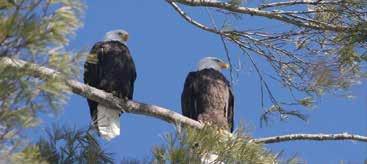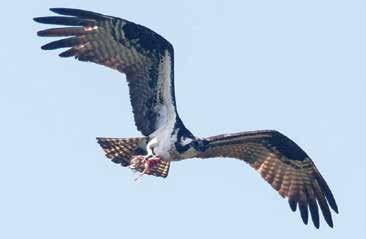
3 minute read
Birds Around Tanglwood Lakes
Robert Packer, lot 208: When will survey results be posted? Tina Budd, lot 366: The statistical survey results will be in the next newsletter.
R. Packer: Can the comments from the survey be put on the website? The Board: Yes.
R. Packer: Are non-paying residents denied access to the beach? The Board: Yes.
R. Packer: It would be a good idea to resurface / multi-purpose the tennis courts, the handball court and the basketball court as pickleball courts.
James Krug, lot 750: What is the reason behind spending so much money on a gate at the beach? Ron Triani: Non-residents use our beach. There has been vandalism as well.
J. Krug: Why not gate the community? President Brian Faller: It is very costly. Grace Zoccali: The Cloud Crest area cannot be gated so people would be able to come into TLCA anyway.
J. Krug: There should be covered bus stops for children who wait for their school buses. There are a lot of new families with children in TLCA now – why can’t the buses come into the community? Lorraine Kloss, lot 296: Buses need a reason to come into communities. The Public Portion of the meeting ends at 10:40 am. Respectfully submitted, Elisabeth Muller, Administrative Assistant



To Advertise Call Linda at 845-856-1268

The Bald Eagle
A bird of prey found in North America. A sea eagle, it has two known subspecies and forms a species pair with the white-tailed eagle. Its range includes most of Canada and Alaska, all of the contiguous United States, and northern Mexico. Wikipedia Wingspan: 5.9 – 7.5 ft. (Adult) Conservation status: Least Concern (Population increasing) Encyclopedia of Life Mass: 6.6 – 14 lbs Lifespan: 20 years (In the wild) Speed: 75 – 99 mph (Diving) Scientific name: Haliaeetus leucocephalus
Birds Around Tanglwood Lakes
Photos courtesy of Lisa Mickley What do You Know About Birds of Prey? Source: Hawkwatch.org For millennia, countless cultures have revered birds of prey as representatives of strength, freedom, and the power of nature. Here in the Tanglwood Lakes area with an abundance of streams, ponds, and lakes, we are able to get a front row seat of our neighboring raptors.
The presence of raptors in the wild serves as a barometer of ecological health. Birds of prey are predators at the top of the food chain; because threats like pesticides, habitat loss, and climate change have the most dramatic impact on top predators, we refer to them as indicator species. Researching the population trends of raptors provides a cost-effective and efficient means to detecting environmental change, allowing us to take conservation action that is driven by the latest scientific data. Raptors also play an important ecological role by controlling populations of rodents and other small mammals.
The word “raptor” comes from the Latin word “rapere,” which means to seize or plunder. Today, the word is used to describe a group of birds also known as “birds of prey.” All birds share some common traits such as feathers, wings, laying eggs, and being warm-blooded; however, there are certain characteristics that set raptors apart from other birds. Raptors have these specialized adaptations: (1) Exceptional vision to see prey from afar, (2) Sharp talons to catch and hold prey, (3) Hooked upper bill to tear apart food.

Size: Osprey have an average 59- to 70-inch wingspan and weigh 3-4 pounds. 2. Diet: Osprey eat a diet of about 99 percent fish, usually 4-12 inches long. The osprey or more specifically the western osprey — also called sea hawk, river hawk, and fish hawk — is a diurnal, fish-eating bird of prey with a cosmopolitan range. It is a large raptor, reaching more than 60 cm in length and 180 cm across the wings. Wikipedia. Scientific name: Pandion haliaetus Family: Pandionidae Kingdom: Animalia Order: Accipitriformes Phylum: Chordata









